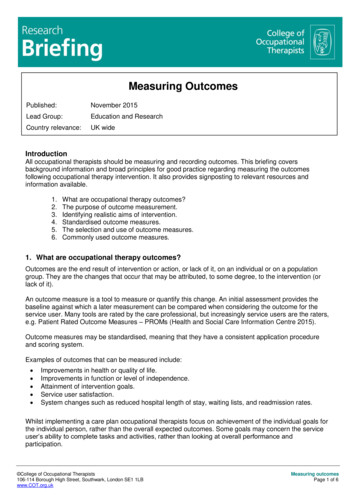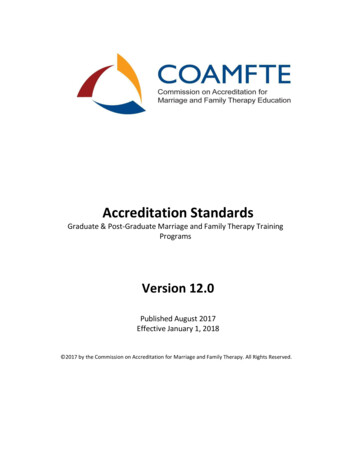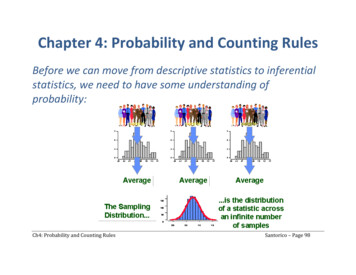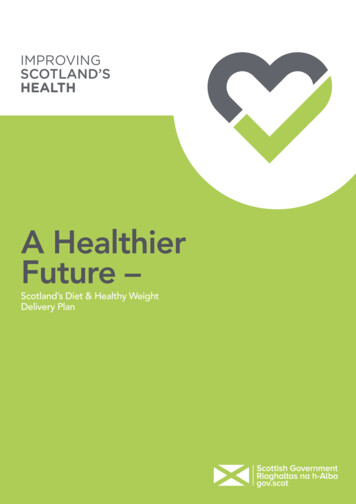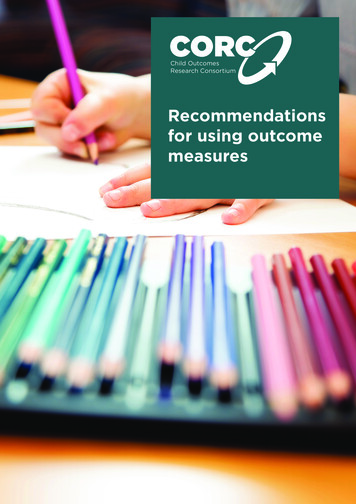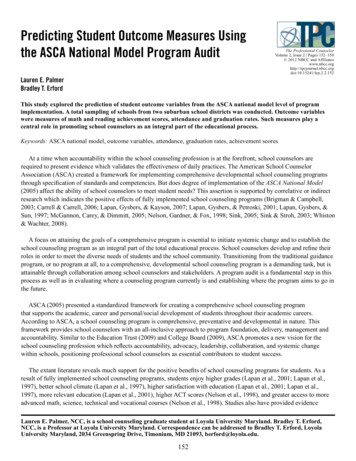
Transcription
Predicting Student Outcome Measures Usingthe ASCA National Model Program AuditThe Professional CounselorVolume 2, Issue 2 Pages 152–159 2012 NBCC and i:10.15241/lep.2.2.152Lauren E. PalmerBradley T. ErfordThis study explored the prediction of student outcome variables from the ASCA national model level of programimplementation. A total sampling of schools from two suburban school districts was conducted. Outcome variableswere measures of math and reading achievement scores, attendance and graduation rates. Such measures play acentral role in promoting school counselors as an integral part of the educational process.Keywords: ASCA national model, outcome variables, attendance, graduation rates, achievement scoresAt a time when accountability within the school counseling profession is at the forefront, school counselors arerequired to present evidence which validates the effectiveness of daily practices. The American School CounselorAssociation (ASCA) created a framework for implementing comprehensive developmental school counseling programsthrough specification of standards and competencies. But does degree of implementation of the ASCA National Model(2005) affect the ability of school counselors to meet student needs? This assertion is supported by correlative or indirectresearch which indicates the positive effects of fully implemented school counseling programs (Brigman & Campbell,2003; Carrell & Carrell, 2006; Lapan, Gysbers, & Kayson, 2007; Lapan, Gysbers, & Petroski, 2001; Lapan, Gysbers, &Sun, 1997; McGannon, Carey, & Dimmitt, 2005; Nelson, Gardner, & Fox, 1998; Sink, 2005; Sink & Stroh, 2003; Whiston& Wachter, 2008).A focus on attaining the goals of a comprehensive program is essential to initiate systemic change and to establish theschool counseling program as an integral part of the total educational process. School counselors develop and refine theirroles in order to meet the diverse needs of students and the school community. Transitioning from the traditional guidanceprogram, or no program at all, to a comprehensive, developmental school counseling program is a demanding task, but isattainable through collaboration among school counselors and stakeholders. A program audit is a fundamental step in thisprocess as well as in evaluating where a counseling program currently is and establishing where the program aims to go inthe future.ASCA (2005) presented a standardized framework for creating a comprehensive school counseling programthat supports the academic, career and personal/social development of students throughout their academic careers.According to ASCA, a school counseling program is comprehensive, preventative and developmental in nature. Thisframework provides school counselors with an all-inclusive approach to program foundation, delivery, management andaccountability. Similar to the Education Trust (2009) and College Board (2009), ASCA promotes a new vision for theschool counseling profession which reflects accountability, advocacy, leadership, collaboration, and systemic changewithin schools, positioning professional school counselors as essential contributors to student success.The extant literature reveals much support for the positive benefits of school counseling programs for students. As aresult of fully implemented school counseling programs, students enjoy higher grades (Lapan et al., 2001; Lapan et al.,1997), better school climate (Lapan et al., 1997), higher satisfaction with education (Lapan et al., 2001; Lapan et al.,1997), more relevant education (Lapan et al., 2001), higher ACT scores (Nelson et al., 1998), and greater access to moreadvanced math, science, technical and vocational courses (Nelson et al., 1998). Studies also have provided evidenceLauren E. Palmer, NCC, is a school counseling graduate student at Loyola University Maryland. Bradley T. Erford,NCC, is a Professor at Loyola University Maryland. Correspondence can be addressed to Bradley T. Erford, LoyolaUniversity Maryland, 2034 Greenspring Drive, Timonium, MD 21093, berford@loyola.edu.152
The Professional Counselor\Volume 2, Issue 2of fewer classroom disruptions and improved peer behavior among students who participated in comprehensive schoolcounseling programs (Brigman & Campbell, 2003; Lapan, 2001; Lapan et al., 2007; Lapan et al., 1997; Sink, 2005; Sink& Stroh, 2003).The program audit is an evaluation tool used to determine the extent to which components of a comprehensive programare implemented and helps to make decisions concerning future directions that a school counseling program will take.A program audit, or process evaluation, assists school counselors in implementing the standards and components of acomprehensive school counseling program, in addition to identifying areas for improvement or enhancement (ASCA,2005). ASCA has suggested that a program audit be completed annually to determine the strengths and weaknessesevident within a school counseling program with regard to the four main elements of the ASCA National Model:foundation, delivery system, management system and accountability. Specific criteria under each component are used as away to evaluate implementation of the school counseling program.This study examined the prediction of student outcomes, including achievement scores, attendance and graduationrate, using level of implementation of the ASCA National Model (2005) as a predictor variable. It was hypothesized thatlevel of program implementation would be a significant predictor of student outcomes at each of the three school levels:elementary, middle and high school. The study also determined coefficients alpha for the ASCA Program Audit for thetotal sample and each academic level.MethodParticipantsA nonrandomized cluster sampling of two public school districts located in Maryland was conducted to selectparticipants for the study. These two public school systems housed a total of 111 elementary schools, 30 middle schools,and 23 high schools for a total of 164 schools. Each participating school had at least one professional school counselorand a school counseling program in place. In the instances where multiple school counselors were assigned to schools, thedata were provided by the guidance chair or lead counselor. School counselors from two alternative schools responded,but were eliminated from the sample due to dissimilarity with the traditional high schools and small sample size. Thus, atotal of 78 (70%) elementary schools, 17 (57%) middle schools, and 18 (78%) high schools participated for a total sampleof 113 schools (69%) within the two participating school districts.InstrumentThe ASCA Program Audit (ASCA, 2005) served as an independent variable for this study. The audit takesapproximately 30–45 minutes to complete the 115 prompts and uses a Likert-type scale to evaluate the components ofa counseling program along the continuum of “None” (meaning not in place), “In progress” (perhaps begun, but notcompleted), “Completed” (but perhaps not as yet implemented), “Implemented” (fully implemented), or “Not applicable”(for situations where the component does not apply). For the purposes of this study, these response choices were coded 0,1, 2, 3, and 0, respectively. Once a program audit is completed, the information can be used to determine implementationstrengths of the program, areas of the program which need strengthening, and short-range and long-range goals forimplementation improvement.This is the first published study to use the complete ASCA Program Audit as a study independent variable. Oneother study, a dissertation (Wong, 2008), used facets of the ASCA Program Audit as an independent variable. Wongconstructed a survey which was modified from the ASCA Program Audit in a study designed to describe the relationshipbetween comprehensive school counseling programs and school performance. Wong’s use of regression analysis yieldeda positive relationship and predictive model between these two variables, but no information regarding the psychometriccharacteristics of the scale. Internal consistency information from the current study’s sample is provided in the resultssection.153
The Professional Counselor\Volume 2, Issue 2ProceduresThe method used to select participants was a nonrandomized cluster sampling of two districts from among 24 publicschool districts located in Maryland. Once IRB approval was received, letters were mailed out over the summer and earlyin the academic year to school counselors of elementary, middle and high schools within each of the two school districtsselected for participation. Inclusion of school counselor supervisors assisted in the distribution and administration ofthis study and increased return rates of completed program audits. The school counselors of each participating schoolwere provided with the program audit from the ASCA National Model (2005), a statement of rationale for the study anda consent form. The school counselors completed the program audit during the months of June through February withinstructions to retrospectively evaluate implementation of the school counseling program components at the end of theprevious (2009-2010) academic year. Demographic data, graduation rates, attendance and scores from the Maryland StateAssessment (MSA) for grades 5, 8 and 10 were obtained from 2009-2010 Maryland Report Cards as retrieved from theMaryland State Department of Education website (http://mdreportcard.org/).The dependent variable of achievement was measured using MSA math and reading scores and defined operationallyas the percentage of those students of a given grade not meeting the criterion for passing (i.e., percentage of studentsreceiving only basic scores), separately for the reading and math components. The MSA is administered to students ingrades 3–5 at the elementary level, grades 6–8 at the middle school level and during the 10th grade in high school. Fifthgrade scores, 8th grade scores and 10th grade scores (English and algebra) were used for these analyses, reasoning thatthese scores reflected the cumulative intervention of prolonged exposure to the school’s curricular experience.The dependent variable of attendance was defined as the percent of average daily attendance including ungradedstudents in special education programs (Maryland State Department of Education, 2010). The dependent variable ofgraduation rate was defined by MSDE as the percentage of students who received a Maryland high school diploma duringthe school year. More specifically, the graduation rate is calculated by “dividing the number of high school graduates bythe sum of the dropouts for grades 9 through 12, respectively, in consecutive years, plus the number of number of highschool graduates (MSDE, 2010, para 1).” Since graduation rate and dropout rate in this sample were highly correlated (r -.752, p .001, n 18), graduation rate was used in the analysis, while dropout rate was excluded as redundant.AnalysisThe data from the demographic and program audit forms were coded into an SPSS database. The total audit scorewas used to determine the level of program implementation. Data marked as “N/A” or “none” were coded as 0 to reflectno attempt at implementation, even though the actual audit reported them separately. “In progress” was coded as a 1,“completed” was coded as a 2, and “implemented” was coded as a 3. The total audit score was the simple sum of scoresfor the 115 responses. Appropriate Pearson family correlation coefficients were applied to analyze relationships betweenthe total audit score (program implementation), student-to-counselor ratio and school outcome measures. Simple linearregression analyses were conducted to determine whether degree of model program implementation was a significantpredictor of student outcomes of achievement scores, attendance and graduation rate at each level: elementary, middle andhigh school.ResultsOf the 164 schools in the two participating school districts, 115 (70%) returned completed consent, demographic andprogram audit forms for analysis. Two high schools were eliminated because they were designated alternative schools.Thus, a total participation rate of 113 schools (69%) was obtained. Type I error (α) was set at the .05 level of probabilityfor all analyses. Trends were indicated by probability levels of p .10. Effect sizes for r or R were interpreted as follows(Cohen, 1988): .10 indicated a small effect; .30 indicated a medium effect; and .50 indicated a large effect.This study provides the first reported analysis of internal consistency of a program audit (ASCA, 2005). Internalconsistency was measured using Cronbach’s coefficient alpha. Alphas were calculated to determine the level of internalconsistency of the total scale and each of the 17 sections of the program audit on the current total sample (n 113), andseparately for the elementary (n 78), middle (n 17) and high school (n 18) samples. Table 1 provides a summary of154
The Professional Counselor\Volume 2, Issue 2these coefficients alphas for the total sample and disaggregated by elementary, middle and high school samples. For the totalscale of 115 items, the α of .98 indicated an extraordinarily high degree of internal consistency. The program audit yieldedan adequate degree of internal consistency for all 17 sections, ranging from α .69–.99 for the total sample, with a median αof .89.Table 1Cronbach’s Alpha of ASCA National Model (2005) Program AuditSection# ofItemsα Total(n 113)α Elementary(n 78)α Middle(n 17)α High(n 18)All115Total Audit Score.98.93.93.96I10Beliefs and Philosophy.94.93.94.96II7Mission of School CounselingPrograms.97.97.85.98III5Domains and Goals.88.88.85.91IV5ASCA ce Curriculum.74.76.76.73VI6Individual Student Planning.88.88.86.80VII9Responsive Services.84.85.88.74VIII4System Support.69.72.65.37IX4School Counselor/ AdministratorAgreements.78.82.85.69X4Advisory Council.99.99.98.98XI7Use of Data and StudentMonitoring.90.90.84.74XII4Use of Data and Closing the Gap.90.91.86.86XIII11Action Plans.93.92.92.95XIV8Use of Time/Calendar.84.85.85.66XV12Results Report.95.96.92.92XVI7Counselor Performance Standards.96.96.89.98XVII8Program Audit.86.88.84.78Total Audit t Section TitleCorrelation coefficients were calculated between the predictor and outcome variables and presented in Table 2 for theelementary and middle schools, and Table 3 for the high school samples. A cursory inspection of the outcome variablesindicates strong intercorrelations, yielding magnitudes of r .50 in all instances, which are large effect sizes. Correlationsbetween the program audit predictor variable and outcome measures at the elementary and middle school levels were notsignificant (p .05, see Table 2) and yielded small effect sizes ranging from .10 to .20 (adjusted for directional effects).155
The Professional Counselor\Volume 2, Issue 2However, at the high school level (see Table 3), significant correlations and large effect sizes were noted between theprogram audit predictor variable and high school outcome measures. Descriptive statistical analysis indicated that allvariables were normally distributed with the one exception: the elementary reading outcome had a skewness index of1.42.Table 2Pearson Correlations Among Predictor and Outcome VariablesRatioAuditReadingMathAttendanceElementary School .16.38*---.20-.14.10--.70*-.55*---.52*---Middle School .53*.62*--.11-.12.10--.89*-.76*---.76---abNote. Elementary school sample (n 78); Middle school sample (n 17); * correlation was significant at p .05.Table 3Pearson Correlations Among Predictor and Outcome Variables for the High School --.74*-.53*--.79*---Note. n 18. * means the correlation was significant at p .05.To assess the proportion of variance in outcomes that could be uniquely accounted for by the ASCA program audit,simple linear regression analysis was used to test the hypothesis that a program audit would significantly predict eachoutcome variable at each of the three school levels (elementary, middle and high). These regression results are presentedin Table 4. Program audit scores did not significantly predict any student outcome measure scores at either the elementaryor middle school level, although the prediction of fifth grade reading achievement trended toward significance (p .08).However, at the high school level (n 18), program audit predicted English (β -.645, t -3.27, p .05, large effect),algebra (β -.517, t -2.34, p .05, large effect), and attendance (β .506, t 2.35, p .05, large effect) outcomes, anda trend was noted in the prediction of high school graduation rate (β .442, t 1.97, p .06, medium to large effect).156
The Professional Counselor\Volume 2, Issue 2Table 4Regression Analyses for the Elementary, Middle and High School Sample Outcome VariablesAdj R2SEStan .203-.143.103.08.22.37Middle School -.118.098.67.65.71High School OutcomescEnglishAlgebraAttendanceGraduation .506.442.01.03.03.06aElementary School OutcomesReadingMathAttendanceNote. a Elementary school sample n 78; b Middle school sample n 17; c High school sample n 18. Type I error set atSignificance (p) .05; p .10 indicates a trend.DiscussionThe purpose of the study was to determine whether level of ASCA National Model (2005) program implementationpredicted student outcomes (i.e., achievement scores, attendance and graduation rates). Results indicated that noprediction was observed at either the elementary or middle school levels on any of the outcome variables (reading, mathor attendance). At the high school level, the data showed that as program implementation increased the percentage ofstudents scoring basic on the MSA English and algebra decreased, which is a positive result. Likewise, at the high schoollevel when program implementation increased, so did attendance and the related trend of increased high school graduationrates. Thus, the hypothesis that higher program implementation would predict better student achievement received mixedsupport and suggested a need for high school counselors to implement comprehensive developmental programs in order tobenefit all students and improve important school and student outcomes.Why these high school findings were not replicated at the elementary and middle school levels is puzzling, as theextant literature demonstrates a significant relationship between program implementation and student outcomes at alllevels of schooling. One explanation may lie in the samples used for this study. The sample sizes used at the middle andhigh school levels were small, 17 and 18, respectively, reducing the power of the analyses, while the elementary samplewas much larger (n 78). A cursory inspection of the means and standard deviations from these three samples (see Table1) indicates that the elementary sample had the lowest level of overall program implementation and the largest spread inscores (M 215.1, SD 66.3), compared to middle school (M 222.4, SD 53.7) and high school (M 243.6, SD 47.5). However, usually greater variations in scores lead to better predictions.Study Limitations and Areas for Future ResearchAdditional inquiry regarding the implementation of comprehensive school counseling programs and student outcomesis necessary to determine the link between student outcomes and school counseling services. Some researchers havepointed out that previous investigations into this area of study have yielded deceiving results (Brown & Trusty, 2005;McGannon et al., 2005). For example, many of the studies used research designs and procedures that did not justify157
The Professional Counselor\Volume 2, Issue 2a causal relationship between counseling programs and positive outcomes. Indeed, the present study was correlationalin nature, so causative inferences cannot be made. This study did not use a controlled treatment intervention and cannotdetermine a causal relationship between level of program implementation and more positive student outcomes. The smallsample sizes of the middle school and high school counselors may have affected the results as well.Various confounding variables exist in the current and previous studies, such as other co-occurring educational programs,and school organizational structure and leadership, all of which tend to influence academic achievement. Moreover, some ofthe data collected within these previous studies are self-reported and not cross-validated with multiple sources of informationor informants. In studies that compare counseling programs and student achievement, Berliner and Biddle (1995) notedthat researchers often fail to control for pupil expenditure, which is not always equivalent to socio-economic status as manypresume because of high correlations (Brown & Trusty, 2005). Failure to control for socio-economic status also can confoundthe results which may be a factor in this study, although using only two large school systems may have provided somecontrol for per pupil expenditure rates.McGannon et al. (2005) emphasized the need for standardized achievement scores and other institutional data,intervention effect sizes and a measure of the quality of implementation of the program to be included in future studies toensure worthy findings. Brown and Trusty (2005) recommended the use of proximal outcomes which include the targetof interventions used with students (e.g., the development of specific ASCA competencies). Instead of using proximaloutcomes, Brown and Trusty pointed out the overuse of distal outcomes (e.g., ACT scores, achievement test scores, schoolgrades) which are affected by a number of factors rather than as a direct result of school counselor services. While proximaloutcomes such as developing competencies including those within the ASCA model may be beneficial to report, the methodsused to establish these competencies also becomes the focus of scrutiny.Longitudinal and experimental design studies which include control and treatment groups are necessary to establishcausal relationships. Correlational studies are often selected as the analysis tool of choice because of expediency and ease.Longitudinal studies take years to complete and are subject to student attrition. Experimental studies in schools also arecomplicated by trying to locate a school willing to serve as the control group (i.e., a school that does not have a counselingprogram in place or a school counselor on staff).Outcome research plays a central role in promoting school counselors as an integral part of the educational process. Itis critical for school counselors to use interventions and program components which provide positive student outcomes(McGannon et al., 2005) and to be knowledgeable of current research relevant to their position and the population they serve.ReferencesAmerican School Counselor Association. (2005). The ASCA national model: A framework for school counseling programs(2nd ed.). Alexandria, VA: Author.Berliner, D. C., & Biddle, B. J. (1995). The manufactured crisis: Myths, fraud, and the attack on America’s public schools.Reading, MA: Addison-Wesley.Brigman, G., & Campbell, C. (2003). Helping students improve academic achievement and school success behavior.Professional School Counseling, 7, 91–99.Brown, D., & Trusty, J. (2005). School counselors, comprehensive school counseling programs, and academic achievement:Are school counselors promising more than they can deliver? Professional School Counseling, 9, 1–8.Carrell, S. E., & Carrell, S. A. (2006). Do lower student to counselor ratios reduce school disciplinary problems?Contributions to Economic Analysis & Policy, 5, 1–24.Cohen, J. (1988). Statistical power analysis for the behavioral sciences (2nd ed.). Hillsdale, NJ: Erlbaum.College Board. (2009). About us: The College Board. Retrieved from ion Trust. (2009). About the Education Trust. Retrieved from http://www.edtrust.org/dc/aboutLapan, R. T. (2001). Results-based comprehensive guidance and counseling program: A framework for planning andevaluation. Professional School Counseling, 4, 289–299.158
The Professional Counselor\Volume 2, Issue 2Lapan, R. T., Gysbers, N. C., & Kayson, K. (2007). How implementing comprehensive guidance programs improvesacademic achievement for all Missouri students. Jefferson City, MO: Missouri Department of Elementary andSecondary Education, Division of Career Education.Lapan, R. T., Gysbers, N. C., & Petroski, G. (2001). Helping 7th graders be safe and academically successful: A statewidestudy of the impact of comprehensive guidance programs. Journal of Counseling and Development, 79, 320–330.Lapan, R. T., Gysbers, N. C., & Sun, Y. (1997). The impact of more fully implemented guidance programs on the schoolexperiences of high school students: A statewide evaluation study. Journal of Counseling and Development, 75,292–302.McGannon, W., Carey, J., & Dimmitt, C. (2005). The current status of school counseling outcome research. Amherst, MA:Center for School Counseling Outcome Research, University of Massachusetts, Amherst.Maryland State Department of Education. (2010). 2010 Maryland Report Card. [Data File]. Retrieved fromwww.mdreportcard.orgNelson, D. E., Gardner, J. L., & Fox, D. G. (1998). An evaluation of the comprehensive guidance program in Utah publicschools. Salt Lake City, UT: Utah State Office of Education.Sink, C. A. (2005). Comprehensive school counseling programs and academic achievement—A rejoinder to Brown andTrusty. Professional School Counseling, 9, 9–12.Sink, C. A., & Stroh, H. R. (2003). Raising achievement test scores of early elementary school students throughcomprehensive school counseling programs. Professional School Counseling, 6, 350–364.Whiston, S. C., & Wachter, C. (2008). School counseling, student achievement, and dropout rates: Student outcomeresearch in the state of Indiana (Special Report). Indianapolis, IN: Indiana State Department of Education.Wong, K. S. (2008). School counseling and student achievement: The relationship between comprehensive schoolcounseling programs and school performance. [Doctoral dissertation]. Retrieved from Dissertation AbstractsInternational Section A: Humanities and Social Sciences. (AAT 3322290) .159
Association (ASCA) created a framework for implementing comprehensive developmental school counseling programs through specification of standards and competencies. But does degree of implementation of the ASCA National Model (2005) affect the ability of school counselors to meet student needs? This assertion is supported by correlative or indirect
